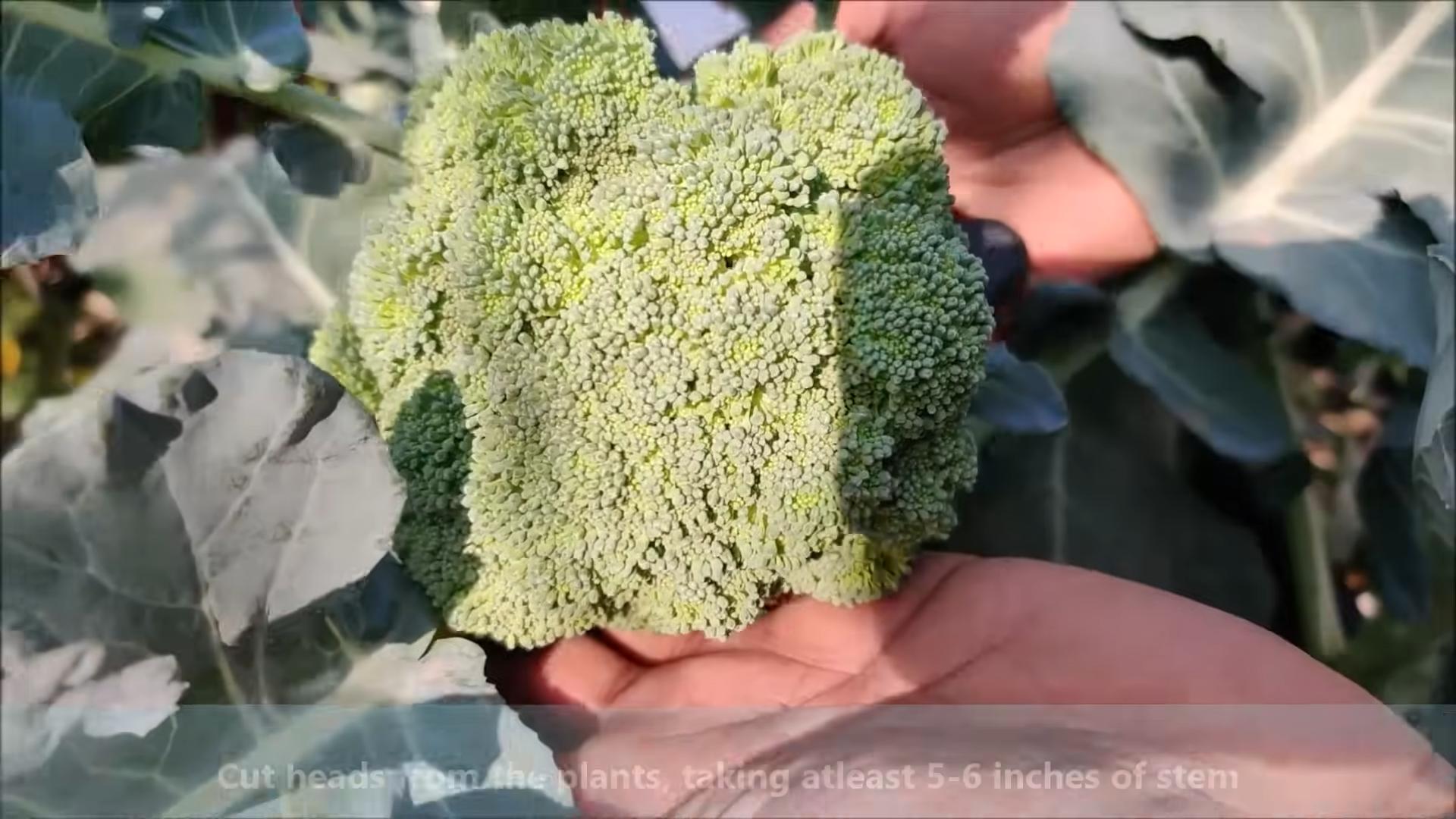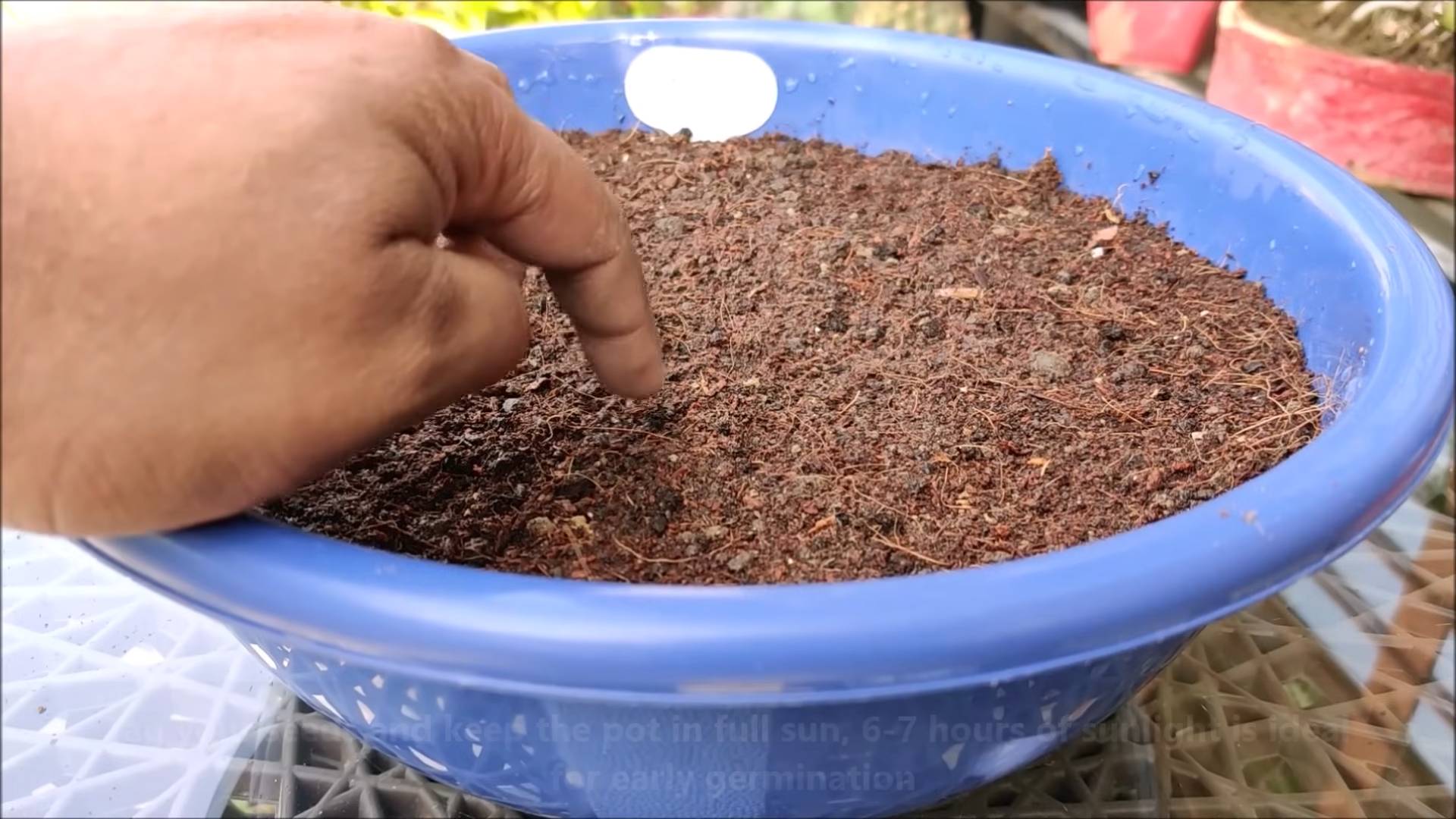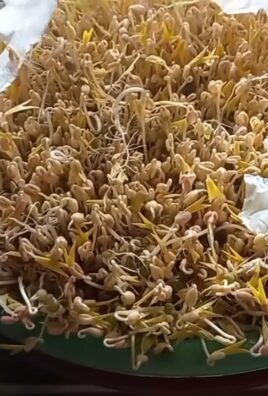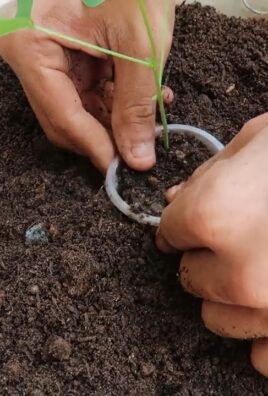Grow Broccoli at Home – sounds intimidating, right? Trust me, it’s not! Forget those expensive grocery store runs for limp, lackluster broccoli. I’m about to let you in on some simple, yet incredibly effective, DIY tricks that will have you harvesting your own vibrant, delicious broccoli right from your backyard (or even your balcony!).
Broccoli, a member of the brassica family, has a rich history dating back to the Roman Empire. For centuries, it’s been prized for its nutritional value and unique flavor. But you don’t need to be an ancient Roman farmer to enjoy the fruits (or rather, the florets!) of your labor.
In today’s world, where we’re all looking for ways to eat healthier, save money, and connect with nature, learning to grow broccoli at home is more relevant than ever. Imagine the satisfaction of serving a meal featuring broccoli you nurtured from seed to table. Plus, homegrown broccoli tastes infinitely better than anything you can buy in a store. It’s fresher, crisper, and packed with flavor.
This article is your ultimate guide to unlocking the secrets of successful home broccoli cultivation. We’ll cover everything from choosing the right varieties to protecting your plants from pests, all with easy-to-follow DIY solutions. So, grab your gardening gloves, and let’s get started!

Growing Broccoli at Home: A Beginner’s Guide
Okay, so you want to grow broccoli at home? Awesome! It’s totally doable, even if you don’t have a huge garden. I’ve been growing my own broccoli for a few years now, and let me tell you, there’s nothing quite like harvesting your own fresh, crisp heads. This guide will walk you through everything you need to know, from starting seeds to dealing with pests. Let’s get started!
What You’ll Need
Before we dive into the nitty-gritty, let’s gather our supplies. Here’s a checklist of everything you’ll need to successfully grow broccoli:
* **Broccoli Seeds:** Choose a variety that suits your climate and growing season. Some popular choices include ‘Waltham 29’, ‘DiCicco’, and ‘Calabrese’.
* **Seed Starting Trays or Pots:** These are essential for starting your seeds indoors.
* **Seed Starting Mix:** This is a light, sterile soil mix specifically designed for seedlings.
* **Larger Pots (if transplanting):** If you’re starting indoors, you’ll need larger pots to transplant your seedlings into before moving them outdoors.
* **Garden Soil or Raised Bed:** Broccoli needs well-draining, fertile soil.
* **Compost or Other Organic Matter:** Amending your soil with compost will provide essential nutrients.
* **Fertilizer:** A balanced fertilizer (like 10-10-10) or a fertilizer specifically formulated for vegetables.
* **Watering Can or Hose:** For regular watering.
* **Gardening Gloves:** To protect your hands.
* **Trowel or Shovel:** For planting and transplanting.
* **Row Covers (optional):** To protect your plants from pests like cabbage moths.
* **Insecticidal Soap (optional):** For dealing with pest infestations.
Starting Your Broccoli Seeds
This is where the magic begins! You can either direct sow your broccoli seeds into the garden, or start them indoors. I prefer starting indoors because it gives the seedlings a head start and protects them from early-season pests.
1. **Timing is Key:** Broccoli is a cool-season crop, meaning it thrives in cooler temperatures. For a spring harvest, start your seeds indoors about 6-8 weeks before the last expected frost. For a fall harvest, start your seeds indoors in mid-summer. Check your local frost dates to determine the best time to start.
2. **Prepare Your Seed Starting Trays:** Fill your seed starting trays or pots with seed starting mix. Gently pat down the soil to remove any air pockets.
3. **Sow the Seeds:** Make a small indentation (about 1/4 inch deep) in the soil of each cell or pot. Place 2-3 broccoli seeds in each indentation. Cover the seeds with a thin layer of seed starting mix.
4. **Water Gently:** Water the trays or pots gently using a watering can or spray bottle. You want to moisten the soil without disturbing the seeds.
5. **Provide Warmth and Light:** Place the trays or pots in a warm location (around 70-75°F) and provide plenty of light. A sunny windowsill or a grow light will work well.
6. **Keep the Soil Moist:** Keep the soil consistently moist, but not soggy. Water when the top inch of soil feels dry to the touch.
7. **Thin the Seedlings:** Once the seedlings have emerged and have a couple of true leaves (the second set of leaves), thin them to one seedling per cell or pot. Choose the strongest, healthiest-looking seedling and snip off the others at the soil line. Don’t pull them out, as this can disturb the roots of the remaining seedling.
Transplanting Your Broccoli Seedlings
Once your seedlings have developed several sets of true leaves and are about 4-6 inches tall, they’re ready to be transplanted into the garden.
1. **Harden Off the Seedlings:** Before transplanting, you need to “harden off” the seedlings. This means gradually acclimating them to outdoor conditions. Start by placing the trays or pots outdoors in a sheltered location for a few hours each day, gradually increasing the amount of time they spend outside over the course of a week. This will help them adjust to the sun, wind, and temperature changes.
2. **Prepare the Garden Bed:** Choose a location that receives at least 6 hours of sunlight per day. Broccoli needs well-draining, fertile soil. Amend the soil with compost or other organic matter to improve its fertility and drainage.
3. **Planting Time:** Dig holes that are slightly larger than the root balls of the seedlings. Space the holes about 18-24 inches apart.
4. **Gently Remove the Seedlings:** Carefully remove the seedlings from their trays or pots. Gently loosen the roots if they are tightly bound.
5. **Plant the Seedlings:** Place the seedlings in the holes and backfill with soil. Make sure the top of the root ball is level with the surrounding soil.
6. **Water Thoroughly:** Water the newly transplanted seedlings thoroughly.
7. **Mulch (Optional):** Apply a layer of mulch around the plants to help retain moisture, suppress weeds, and regulate soil temperature.
Caring for Your Broccoli Plants
Now that your broccoli plants are in the ground, it’s time to provide them with the care they need to thrive.
1. **Watering:** Broccoli needs consistent moisture, especially during hot, dry weather. Water deeply and regularly, aiming to keep the soil consistently moist but not soggy.
2. **Fertilizing:** Broccoli is a heavy feeder, meaning it needs plenty of nutrients. Fertilize your plants every 2-3 weeks with a balanced fertilizer or a fertilizer specifically formulated for vegetables. Follow the instructions on the fertilizer package.
3. **Weeding:** Keep the garden bed free of weeds, as they can compete with your broccoli plants for nutrients and water. Hand-pull weeds regularly or use a hoe to cultivate the soil.
4. **Pest Control:** Broccoli is susceptible to a variety of pests, including cabbage moths, aphids, and flea beetles.
* **Cabbage Moths:** These pests lay eggs on the leaves of broccoli plants, and the larvae (cabbage worms) can cause significant damage. You can prevent cabbage moths by covering your plants with row covers. You can also hand-pick the worms off the plants or use an organic insecticide like Bacillus thuringiensis (Bt).
* **Aphids:** These small, sap-sucking insects can weaken broccoli plants. You can control aphids by spraying them with a strong stream of water or by using insecticidal soap.
* **Flea Beetles:** These tiny beetles can chew small holes in the leaves of broccoli plants. You can control flea beetles by using row covers or by spraying them with insecticidal soap.
5. **Support (Optional):** As your broccoli heads grow larger, they may become heavy and cause the plants to topple over. You can provide support by staking the plants or by using tomato cages.
Harvesting Your Broccoli
The moment you’ve been waiting for! Harvesting your own broccoli is incredibly rewarding.
1. **Timing is Everything:** Broccoli is ready to harvest when the heads are firm, tight, and a deep green color. The individual flower buds should be tightly closed. If the buds start to open and turn yellow, it’s time to harvest immediately.
2. **Cut the Head:** Use a sharp knife to cut the main head of broccoli from the plant. Cut the stem at an angle, leaving a few inches of stem attached to the head.
3. **Encourage Side Shoots:** After harvesting the main head, the plant will often produce side shoots. These smaller heads can be harvested as they mature.
4. **Enjoy Your Harvest:** Broccoli is best enjoyed fresh. You can eat it raw, steamed, roasted, or stir-fried. Store your harvested broccoli in the refrigerator for up to a week.
Troubleshooting
Even with the best care, you may encounter some problems while growing broccoli. Here are a few common issues and how to address them:
* **Yellowing Leaves:** This can be caused by a variety of factors, including nutrient deficiencies, overwatering, or pest infestations. Check the soil pH and nutrient levels, adjust your watering schedule, and inspect the plants for pests.
* **Small Heads:** This can be caused by insufficient sunlight, poor soil fertility, or overcrowding. Make sure your plants are getting at least 6 hours of sunlight per day, amend the soil with compost, and thin out the plants if they are too close together.
* **Bolting (Premature Flowering):** This can be caused by hot weather or stress. Broccoli is a cool-season crop, so it’s important to plant it at the right time of year. Provide shade during hot weather and ensure the plants are getting enough water.
* **Root Rot:** This can be caused by overwatering or poorly draining soil. Make sure the soil is well-draining and avoid overwatering.
Extra Tips for Success
* Choose the right variety: Some broccoli varieties are better

Conclusion
So, there you have it! Growing broccoli at home isn’t just a gardening project; it’s a gateway to fresher, more flavorful meals and a deeper connection with the food you eat. We’ve walked you through the essential steps, from selecting the right seeds to harvesting your own vibrant, green heads. The satisfaction of nurturing a plant from seed to table is truly unparalleled, and the taste of homegrown broccoli far surpasses anything you’ll find in the supermarket.
But why is this DIY trick a must-try? Firstly, you have complete control over the growing process. You can choose organic methods, avoiding harmful pesticides and herbicides, ensuring that your family consumes only the healthiest produce. Secondly, the flavor is simply unmatched. Freshly harvested broccoli is sweeter and more tender than store-bought varieties, which often sit in transit for days. Finally, it’s incredibly rewarding! Witnessing the entire life cycle of a plant, from tiny seedling to mature vegetable, is a truly enriching experience.
Don’t be afraid to experiment with different varieties of broccoli. Consider trying Romanesco broccoli for its unique fractal pattern and nutty flavor, or perhaps some purple sprouting broccoli for a splash of color in your garden and on your plate. You can also adjust the planting schedule to extend your harvest season, ensuring a steady supply of fresh broccoli throughout the year. Companion planting is another avenue to explore. Marigolds can deter pests, while herbs like dill and chamomile can attract beneficial insects.
We encourage you to take the plunge and try growing broccoli at home. It’s easier than you might think, and the rewards are well worth the effort. Even if you only have a small balcony or patio, you can still grow broccoli in containers. Remember to provide adequate sunlight, water, and nutrients, and you’ll be well on your way to enjoying your own homegrown harvest.
Once you’ve experienced the joy of growing your own broccoli, we’d love to hear about it! Share your experiences, tips, and photos with us in the comments below. Let’s build a community of home gardeners and inspire others to discover the magic of growing their own food. Embrace the challenge, enjoy the process, and savor the delicious results of your very own homegrown **broccoli**. Happy gardening!
Frequently Asked Questions (FAQ)
Q: What is the best time of year to plant broccoli?
A: The best time to plant broccoli depends on your climate. In cooler climates, you can start seeds indoors 6-8 weeks before the last expected frost and transplant them outdoors a few weeks after the frost. For warmer climates, plant broccoli in the fall for a winter harvest. Broccoli thrives in cooler temperatures, so avoid planting during the hottest months of the year. Check your local frost dates to determine the optimal planting time for your region.
Q: How much sunlight does broccoli need?
A: Broccoli requires at least 6 hours of direct sunlight per day to thrive. Choose a location in your garden that receives ample sunlight throughout the day. If you’re growing broccoli in containers, make sure to place them in a sunny spot. Insufficient sunlight can result in leggy plants and smaller heads.
Q: What kind of soil is best for growing broccoli?
A: Broccoli prefers well-drained, fertile soil with a pH between 6.0 and 7.0. Amend your soil with compost or other organic matter to improve drainage and fertility. You can also add a slow-release fertilizer at planting time to provide essential nutrients. Avoid planting broccoli in heavy clay soil, as it can become waterlogged and hinder growth.
Q: How often should I water broccoli?
A: Broccoli needs consistent moisture to grow properly. Water deeply and regularly, especially during dry periods. Aim to keep the soil consistently moist but not waterlogged. Mulching around the plants can help retain moisture and suppress weeds. Check the soil moisture regularly and adjust your watering schedule accordingly.
Q: What are some common pests and diseases that affect broccoli?
A: Broccoli can be susceptible to several pests and diseases, including cabbage worms, aphids, flea beetles, and clubroot. Inspect your plants regularly for signs of infestation or disease. Use organic pest control methods, such as insecticidal soap or neem oil, to control pests. To prevent clubroot, ensure good soil drainage and avoid planting broccoli in the same location year after year. Crop rotation is crucial for disease prevention.
Q: How do I know when my broccoli is ready to harvest?
A: Broccoli is ready to harvest when the head is firm and the florets are tightly closed. The size of the head will vary depending on the variety, but generally, you should harvest when the head is about 6-8 inches in diameter. Use a sharp knife to cut the head from the plant, leaving a few inches of stem. Side shoots may develop after the main head is harvested, providing additional smaller heads.
Q: Can I grow broccoli in containers?
A: Yes, you can grow broccoli in containers. Choose a large container, at least 12 inches in diameter, with drainage holes. Use a high-quality potting mix and provide adequate sunlight, water, and nutrients. Container-grown broccoli may require more frequent watering and fertilization than broccoli grown in the ground.
Q: What are some good companion plants for broccoli?
A: Several plants can benefit broccoli when planted nearby. Marigolds deter pests, while herbs like dill and chamomile attract beneficial insects. Other good companion plants include onions, garlic, rosemary, and thyme. Avoid planting broccoli near strawberries or tomatoes, as they can compete for nutrients.
Q: How can I prevent broccoli from bolting (going to seed)?
A: Bolting occurs when broccoli is exposed to prolonged periods of hot weather. To prevent bolting, plant broccoli at the right time of year, provide adequate shade during hot weather, and ensure consistent watering. Choose bolt-resistant varieties if you live in a warm climate.
Q: Can I eat the broccoli leaves?
A: Yes, broccoli leaves are edible and nutritious. They can be cooked like kale or collard greens. Choose young, tender leaves for the best flavor. Broccoli leaves are a good source of vitamins A and C, as well as fiber. Don’t discard them; add them to your salads, stir-fries, or soups.




Leave a Comment